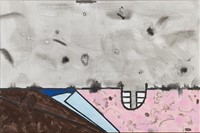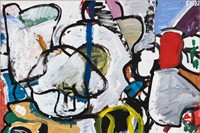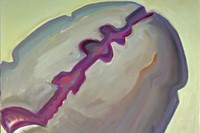A group exhibition at London’s Timothy Taylor gallery – featuring artists including George Rouy, Antonia Showering, Louise Bonnet and Daisy Parris – proves that Guston’s legacy lives on in both paint and politics
At the heart of a new group show at Timothy Taylor gallery in Mayfair, London – A Thing for the Mind – hangs a cryptic painting by the late, great American painter Philip Guston. Against a piggy-pink background, an assortment of seemingly random objects hang suspended on the canvas; a solitary eyeball flanked by lobster-like lashes, a plank of wood, a blue conch shell, a light bulb, a red hand holding a cigarette aloft from underneath a paint-stained sleeve, and a dangling rope. This is Guston’s 1978 painting Story – made in the cartoonish, fleshy style that he turned to in the 1960s following his earlier political murals and abstract expressionist paintings. Of the stylistic change, he famously said: “The war, what was happening to America, the brutality of the world. What kind of man am I, sitting at home, reading magazines, going into frustrated fury about everything – and then going into my studio to adjust a red to a blue?”
Over four decades on from his death, A Thing for the Mind presents work by 12 contemporary artists that continue to be influenced by his work. Colour appears to be the ultimate uniting force here, along with the artists’ gleeful, gestural handling of paint – Walter Price leaves globby pools of it on his glittering canvases, while Louise Bonnet’s monstrous, paunchy figures have much in common with Guston’s own, both proportionally and emotionally. For Antonia Showering, Guston’s power lies in the autobiographical element of his painting – perfectly summarised in Couple in Bed, a 1977 self-portrait where, despite the intimate embrace, Guston appears unable to fully live in the moment – even in bed beside his wife, he’s still clutching a handful of paintbrushes with his shoes on.
“The paintings I love are very gestural, they’re very rich and heavy in terms of emotion,” says George Rouy, whose work False Window is by far the largest in the show, with its seated figure glitching and crackling with energy and colour like a mirage. Elsewhere, the cartoonish, caricature-like elements of Guston’s more political works are channelled by Carroll Dunham, Armen Eloyan and Chris Martin – although no Klansmen appear here. “His work is always going to be relevant politically too, because he painted one of the scariest things; the everyday evil,” explains Daisy Parris, whose frantically colourful painting channels the angst of grief, loneliness and intimacy – themes which also preoccupied Guston.
Below, four artists from the show – Antonia Showering, Lousie Bonnet, George Rouy and Daisy Parris – speak on Guston’s enduring artistic influence.
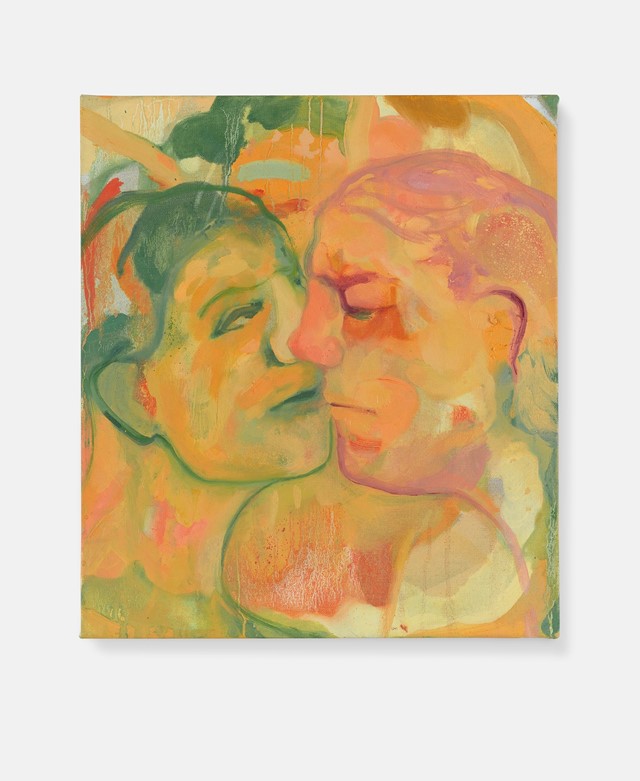
Antonia Showering
“Philip Guston is such an art school canon art school artist, so it’s difficult to pinpoint when I first came across him. But I do remember being recommended by a tutor to read Night Studio: A Memoir Of Philip Guston by his daughter Musa Mayer – I think I was suggested this because I’ve got a tendency to work late into the night. The book was really moving, and because my work focuses a lot on family and memory, it was talking a lot about this ghost of her father in the space where he used to work. There was an atmosphere of him being so present in his studio, with completely untouched cigarettes that were still in the ashtray in the space. It almost felt as if he was going to walk back into the room, but it was written after he had died.
“Guston’s paintings definitely excite me, with his use of colour especially. I don’t think anyone uses pink and green like he does – he marries them together in such a unique way. One of my favourite works that he made is called Couple in Bed, made in 1977. It’s so stripped back, and really raw in how he’s depicted the two figures underneath the blanket. For me, when I look at it, I feel like he’s touching on the difficult balance between [having a] life as a painter and your personal life. It’s a couple in bed; one of the figures is gripping three paintbrushes and the figure has shoes on, so it looks as if there’s only a moment that they’re able to be in this intimate embrace. I relate to that as a painter.
“The painting I have in the show is called Plus One, made in 2021. It’s a loose depiction of a couple who are either about to enter or are just departing from an embrace. One of the figures looks a lot more engaged. It’s about the off-kilter, push-pull nature that can be found in so many things. I like to explore a number of themes in my work; familial relationships and more recently, non-platonic relationships, love or loneliness, intergenerational memory, superstitions, desires and regrets, and lots of other things as well. Oil on linen is my medium.”

Louise Bonnet
“I’m an oil painter, based in Los Angeles. I’m Interested in emotions [that are] made visible through the body.
“I think I saw the Nixon phlebitis painting San Clemente (1975) first. I thought that I wished I could feel so free, so unconcerned with the conventions of ‘art’ to paint something like that. Specifically, for me, because there is a clear link to cartooning in Guston’s paintings which is present in my work as well and that I felt, and still feel sometimes, insecure about.
“[Guston’s legacy is] the freedom to throw out what is supposed to be ‘serious art’ making and also applying this freedom to the choice of subject matter. I think of his work when I start to question if I am doing something wrong – something that is not done.”
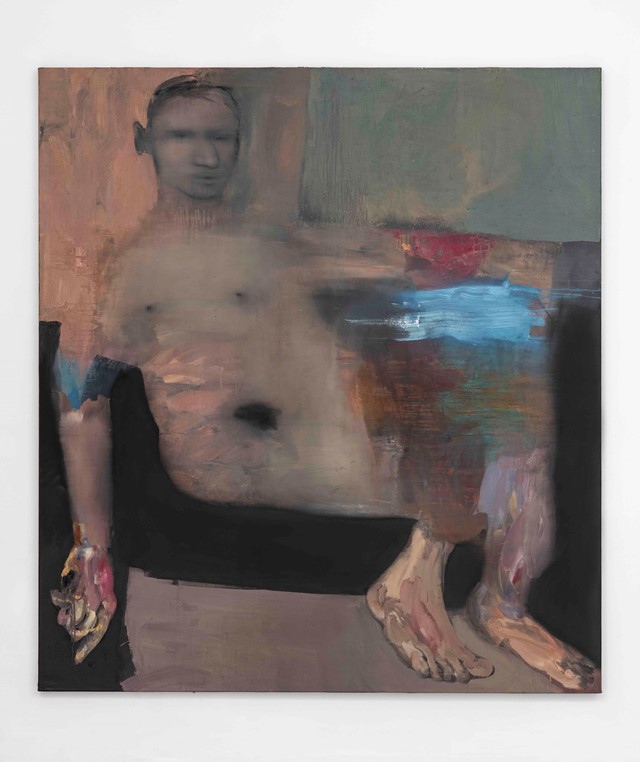
George Rouy
“I’ve known Philip Guston’s work for quite a few years, but actually seeing them in person, less so much. The first time I saw his work was at Frieze – the two pieces there kind of shine out above everything else. They had such a presence in terms of the actual weight of the paint itself and the application. He’s quite a technical painter really, but then [he had] that shift over to more naive, incredible, potent, caricature or cartoony [figures]. There’s just something about the colours and the oil paint as well as the subjects, which are incredible as well.
“I’m super interested in how he shifted from his earlier works, which I find really quite bland and not very inspiring. It’s almost like when you’ve tasted the other part of his work, you never go back to the other bit. From there, [his work] had a ricochet effect, this naivete, this very focused imagery with quite ambitious content. He’s someone who has a clear line that runs through [the work], historically and just legacy-wise. You can see how someone [like him] can have an impact on the medium. I really wanted to be part of the show because I’m a big fan of Guston’s work, but also, it’s about the list of artists ... I’m happy to be included.”
“To get to a point where I wanted my art to be, there was going to be a period of time where I had to go through all the motions with it again, [to] almost deconstruct it and repurpose what the work really meant to me. I’d made a few paintings and I knew which ones were successful and which ones weren’t, and you start to build your own personal philosophy on what you think and where the work sits best for you, and how it can exist in the truest form. When I was boiling that down, it was non-narrative, very focused, figurative works that had a certain symbolism but at the same time were ultimately about the other, which is a more psychological aspect of how you read the figure, or how you read emotion. The paintings I love are very gestural, they’re very rich and heavy in terms of emotion. It’s been a massive journey of endlessly deconstructing all these things, but also at the same time falling in love with the physical side to painting, the marks and what oil and acrylic paint can achieve.
“My painting in the show was made at the beginning of that shift, just before I got into my new studio and produced all that different, new work. The work itself is almost one of the more autobiographical ones. At the time I was really into figures being seated and that relationship of being weighted on a plinth or on a seat meant. I wanted it to feel very classical.”
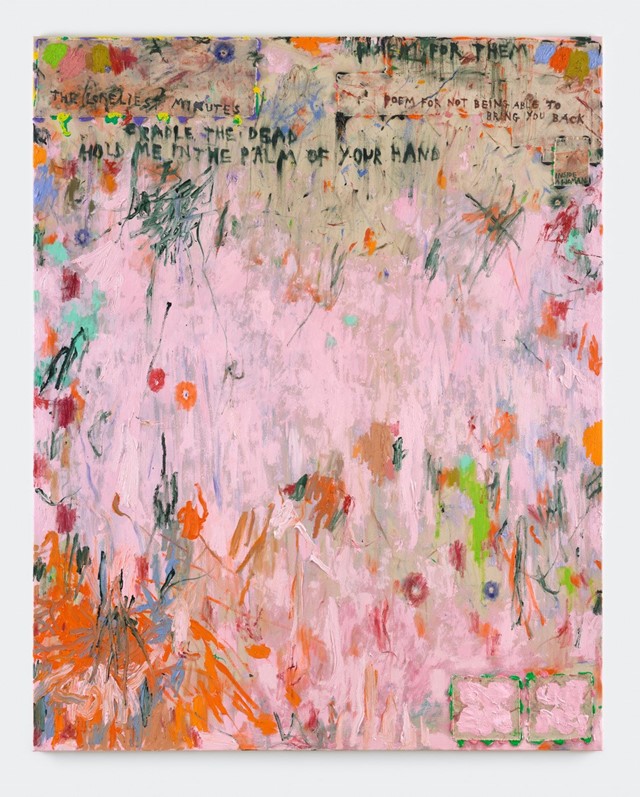
Daisy Parris
“I make paintings using oil paint and collage, and I’m interested in exploring themes of loss, hope, agony, anxiety, identity and emotional extremes.
“It feels like Philip Guston’s work has always been part of my creative consciousness, but I only saw major pieces of his work in the flesh in New York a few years ago. I was hit by the heaviness of them. I remember his use of pink and red radiating out of the surface of the canvas, hitting me like a punch to the guts.
“I think he’ll always be relevant as a painter because he constantly seemed to be challenging painting and reinventing himself as an artist until he found the language he needed to convey the core of human existence. He painted the darkest sides of people. His work is always going to be relevant politically too, because he painted one of the scariest things; the everyday evil.”
“His use of fleshy red and pink tones has really influenced me and is something I keep going back to in my own work. His work ethic makes me want to paint forever and keep working hard.”
A Thing for the Mind is on at Timothy Taylor in Mayfair, London until August 19, 2022.

